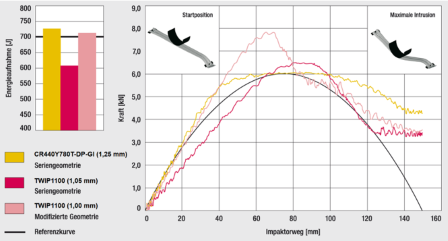Innovation
Study of weight reduction potential of side impact door beams in passenger cars
Modification of door impact beam geometry for weight reduction.
Due to the lower elastic modulus of TWIP steel as compared with HCT780XD “standard steel” (CR440Y780T-DP-GI), simple material substitution resulted only in unsatisfactory component stiffness. For that reason, the geometry had to be modified.
Target specifications included component stiffness, maximum transmissible force, energy absorption, prevention of premature collapse, accommodation of available package space, and potential for low weight. Material and geometry optimization yielded a weight reduction potential of 17%.
Study: Affordable lightweight construction – using steel instead of aluminum
![[Translate to Englisch:] Schaubild](/fileadmin/footage/MEDIA/gesellschaften/szmf/Warum_wir/Bilder-Referenzprojekte/Kostenvorteile-Stahl-vs-Alu-448x250px.PNG)
This study examined lightweight construction that is based on steel and therefore affordable. Based on the example of a two-point aluminum steering control arm, the study investigated the replacement of forged aluminum by higher strength steels in automotive suspensions. The goal was to reduce costs without neglecting the importance of weight.
Procedural approach:
- Conduct empirical and digital analyses to determine the component specifications
- Use numerical optimization to develop conceptual variants
- Estimate potential of component concepts as compared with the aluminum control arm
Results: Steel offers significant cost advantages over aluminum with moderate weight adjustments. Under the given load assumptions, the numerically designed steel components are 28 to 34 percent heavier than the aluminum control arm, but the component costs are up to 54 percent lower than the costs of the aluminum control arm.
Innovation fund project: Lightweight backrest made of HSD steel
Representatives of Sitech GmbH, Volkswagen AG and the Volkswagen Commercial Vehicle Division presented the collaboratively developed results of the innovation fund project "HSD® lightweight steel backrest".
Within the framework of a general project presentation and a detailed discussion on real crashed seat structures, the possibilities of weight reduction (-20 %) and performance improvement (increase in knee clearance +40 mm) were presented and discussed in the materials center with the active participation of SZMF and Salgitter Flachstahl colleagues.


![[Translate to Englisch:] Bild zeigt Gütesiegel "Innovativ durch Forschung"](/fileadmin/footage/MEDIA/gesellschaften/szmf/teaser/Forschungssiegel-Stifterverband_2018.png)
